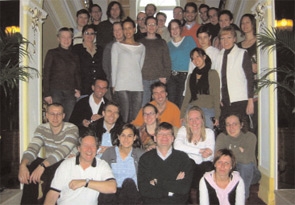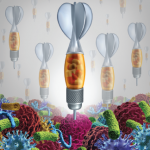
In his medical school days, Josef S. Smolen, MD, was already revealing himself as a “glass half full” kind of person. As proof, consider the following anecdote:
“When I selected rheumatology,” Dr. Smolen recalls with a slight chuckle, “my colleagues in nephrology, cardiology, and endocrinology asked me why I was so crazy to select an area where so little could be done.
“My answer to them was: a) if little could be done, that would be changed; and b) that this was an area where research could be performed yielding more information on pathogenesis and one might be able to find new remedies.”
Dr. Smolen sensed that rheumatology would offer opportunity not only for investigation, but also for helping to reduce burden on patients. “Where there is a lot of burden, even relatively small reductions may mean a lot to the people who are affected,” he says. In the three decades since he completed medical school, Dr. Smolen’s inherent optimism and tireless investigations have yielded important intellectual advancements in the field of rheumatology.
Dr. Smolen is chair of the division of rheumatology at the Medical University of Vienna in Austria and chair of the second department of medicine at the Center for Rheumatic Diseases at Hietzing Hospital in Vienna. He has published over 200 papers in rheumatology and immunology and is perhaps best known for his group’s work on revealing novel pathogenic insights pivotally involved in the evolution of new treatments for RA, such as leflunomide and biologic agents. He is also known for his new look at outcomes in RA, especially the development of the Simplified and the Clinical Disease Activity Indices (SDAI and CDAI), the latter in close collaboration with Daniel Aletaha, MD, a rheumatology fellow at the Medical University of Vienna.
Dr. Smolen has established his department as an important center in the international rheumatology community, helping to usher in huge leaps in our understanding of the disease, as well as advancing treatment improvements. “Josef has been a beacon of the development of informed, scientifically based rheumatology in Europe,” says Peter E. Lipsky, MD, chief of the autoimmunity branch of the National Institute of Arthritis and Musculoskeletal and Skin Diseases (NIAMS) in Bethesda, Md., and a long-time colleague of Dr. Smolen.

Fascinated by Immunological Problems
Dr. Smolen says that, for him, the choice of rheumatology was a natural one. As a medical student, he was fascinated by immunological problems and autoimmune diseases, which were not well understood in the late 60s and early 70s when he attended the University of Vienna. After receiving his MD in 1974, he followed his interests in immunological disease and became a fellow at the university’s Institute of Immunology, studying under his mentor, Professor Carl Steffen.
Following an internal medical residency, which included an 18-month rotation in rheumatology, Dr. Smolen applied for a post-doctoral fellowship in the United States. One of the people with whom Professor Smolen interviewed was Dr. Lipsky, then at the University of Texas Southwestern Medical Center at Dallas.
“During that interview,” recalls Dr. Lipsky, “he asked me very earnestly where I would recommend that he go. Of course, he was looking at a position in Dallas, when I recommended that he go to the NIH!” And, in fact, Dr. Smolen did do a fellowship at the Arthritis and Rheumatism Branch at the NIH, first under Director J.L. Decker, MD, and then in the section for cellular immunology under Chief A.D. Steinberg, MD. Then it was back to Vienna, where he was offered a professorship in rheumatology. “That had been a long-standing professorship,” remarks Dr. Lipsky, “but since Josef has taken it over, he has really developed it into one of the most influential of professorships in Europe.”
From DAREA to SDAI
The CDAI had its beginnings in Dr. Smolen’s activities with international rheumatology organizations. From 1991 to 1997, he served as chair of the European League Against Rheumatism (EULAR) Standing Committee for International Clinical Studies Including Therapeutic Trials (ESCISIT). Discussions in committee meetings during the early to mid 90s identified the need to improve outcomes measures in rheumatology. The Disease Activity Score (DAS) and DAS-28, a continuous scale developed at the University of Nijmegen in the Netherlands by Piet van Riel, MD, PhD, and Desiree van der Heijde, MD, PhD, rose to prominence as therapeutic trials increased. (See “To Measure is to Know,” in the October issue, p. 24, for more on Dr. van Reil and the DAS.)
“I was personally very happy that these new criteria were developed, be it the ACR criteria, the EULAR response criteria, or the DAS-28,” Dr. Smolen notes, and that “they performed well in clinical trials and were something new and helpful. However, all these calculations of response were relatively tedious.” (ACR criteria require calculation of percentages of improvement, and the DAS requires performing square roots and factoring.)
He and his teams at the Hietzing Hospital and the Medical University in Vienna first embarked upon the quest for a simplified disease activity index to meet a need in reactive arthritis, for which there was no existing disease activity score. Because reactive arthritis is usually oligoarticular, they reasoned, they could use the variables most sensitive to change (joint counts, patient and evaluator global assessments, and C-reactive protein [CRP]) and come up with a simple numerical summation of values to assess disease activity. With the help of Gabriele Eberl, MD, of the second department of medicine at Lainz Hospital in Vienna, the Disease Activity index for Reactive Arthritis (DAREA) was developed and validated.1
The advantage of the DAREA was that the physician didn’t need to use a calculator. “You could even [summarize the numbers] in your head,” says Dr. Smolen, “and you wouldn’t even need a pencil or pen.” Then the team wondered if the index would also work for clinical practice in RA. The SDAI was tested and validated in the leflunomide dataset as well as two additional datasets by the Vienna team and other authors.2-5 “We were surprised,” says Dr. Smolen, “how extremely consistent the correlation between all the scores were when this simplified disease activity index was compared to other measures, such as the DAS-28.”
Career Timeline
1974 – Earns MD from the University of Vienna.
1976 – Completes fellowship at the University of Vienna Institute of Immunology.
1981 – Completes fellowship at the NIH.
1982 – Completes residency at the University of Vienna.
1983 – Becomes head of the rheumatology section at the second Dept. of Medicine, University of Vienna.
1985 – Becomes associate professor of clinical immunology.
1987 – Becomes associate professor of internal medicine.
1989 – Becomes chair of the second Dept. of Medicine, University of Vienna.
1991 – Becomes chair of EULAR.
1995 – Becomes professor of internal medicine (rheumatology) and chair of clinical rheumatology at the Medical University of Vienna.
SDAI One Step Further
To continue to streamline clinical assessments, Drs. Smolen and Aletaha went a step further with their disease activity index: they tested whether CRP contributed importantly to the SDAI, and their analyses justified elimination of CRP in the calculation. Physicians would no longer have to wait for lab results of acute phase reactants. They could immediately score their patients’ disease activity and make treatment decisions based upon this calculation. When the team began to analyze the validity of this index, “we were very surprised, again,” recalls Dr. Smolen, “that this simple numerical summation of the 28 swollen and tender joint counts, along with the patient and evaluator global disease activity assessment [0 to 10 on the Visual Analogue Scale], yielded a very reliable score that was sensitive to change.”6
Continued investigations by Dr. Aletaha in concert with Dr. Smolen have revealed yet another advantage of the CDAI: “It has been especially in the recent years where we have realized, with the new therapies, that remission could be achieved,” notes Dr. Smolen. “It turns out that the SDAI and the CDAI were the most stringent composite scores to assess remission.”
As for patients, Dr. Smolen believes that a simple numerical score that integrates disease activity imparts a particularly meaningful benefit. CDAI scores can help patients track their own index of disease activity, much as diabetic patients usually want to know and track their HbA1c results.7
Incorporating routine assessments of disease activity in all RA patients at every clinical visit remains a challenge, concedes Dr. Aletaha, despite the ease of the CDAI and SDAI. “We are dealing with a complex disease and we should not say that it’s too difficult for us to assess patients at every visit. We should get national and international rheumatology societies, as well as funding agencies, to require structured and reliable assessments,” he says, “and Josef is doing a very good job indeed at crusading to get these policies adopted.”
Work Is Fun
Dr. Smolen is well known in rheumatology circles for promoting an informal and interactive tone with his research teams. He has an untiring dedication to collaboration and to fostering a professional environment that many have described as more play than work, says Dr. Aletaha.
Tellingly, Dr. Smolen uses the pronoun “we” instead of “I” when describing the accomplishments of his career. He speaks enthusiastically of his “terrific scientific collaboration with my many great co-workers at the university division over the years,” among them Dr. Aletaha; Martin Aringer, MD, of Klinikum Technical University in Dresden, Germany; Winfried Graninger, MD, of the Rheumatology Med Klink
in Graz, Austria; Hans Kiener, MD, of the University of Vienna; Klaus Machold, MD, of the University of Vienna; Kurt Redlich, MD, of the University of Vienna; Clemens Scheinecker, MD, of Hietzing Hospital; Georg Schett, MD, of Friedrich Alexander University Erlangen, Germany; Tanja Stamm, PhD, of the University of Vienna; and Gunter Steiner, PhD, of the University of Vienna. Likewise, his colleagues at Hietzing Hospital, spearheaded by his deputy Wolfgang Ebner, MD, “are an asset for our clinical research that occurs in close collaboration between the two departments,” he says.
In fact, Michael Mierau, MD, from the Hietzing Hospital department recently published an article on remission in practice, employing the CDAI and SDAI criteria. This and other clinical work is supported by the database (CARAbase) that has been developed in close collaboration between the two departments and is employed for every RA patient. “The clinical work is complemented by the translational research done in experimental models that today lie importantly in the hands of Kurt Redlich, Clemens Scheinecker, and Gunter Steiner,” adds Dr. Smolen. “The process of investigating outcomes—as much as the experimental animal work, basic scientific activities, and research into autoimmunity—has been a lot of fun for all of us.”
Tireless Ambassador
Dr. Smolen’s passion for building the programs in Vienna has been intertwined with advancing awareness of rheumatology within the European community. Dr. Lipsky points out that when Dr. Smolen was president of EULAR, he actively reached out to the European Union, championing the cause to recognize chronic diseases, including the rheumatic diseases, and to incorporate some of the EULAR focuses as targets for research.
“He has had tremendous influence, not only in developing clinical guidelines and developing measures to evaluate clinical activity, but also in developing a scientifically based training program in central Europe, and in terms of the politics of rheumatology, leading to recognition of rheumatology as a legitimate target of investment by the European Union,” says Dr. Lipsky. As Dr. Smolen’s protégés move into their own positions of authority, the network of rheumatologists nurtured by Dr. Smolen will continue to grow. “Even though I think people don’t like to leave the nest there in Vienna—it’s a very nice place—many of them are very talented and now moving into positions elsewhere in Europe and, I think, will continue that network,” says Dr. Lipsky.
“I think this interactive collaboration was one of his agendas when he became chairman of the department,” says Dr. Aletaha. “At the time, the department had a clear focus on basic research, and Dr. Smolen wanted to expand its scientific horizon and move into the field of outcomes research.”
Dr. Smolen continues a very busy schedule, traveling to meetings, supervising research, caring for patients, and staying active with national and international societies. Still, he finds time to relax with family and friends, enjoy concerts and the theater, and indulge in his hobby of collecting literature. (He has written a bibliography in German on a book series published in the early decades of the 20th century—Der jungste Tag.)
Dr. Smolen’s optimism has not dulled in the intervening years since his medical school pronouncements that change would come for RA patients. He always projects a positive attitude, says Dr. Aletaha. “It is always exciting to enter his office,” he continues, “and for some reason there’s always good news. I sometimes wonder, Where does he hide the bad news? Josef has an amazing way to motivate people.”
Gretchen Henkel writes the “Metrics in Rheumatology” series.
References
- Eberl G, Studnick A, Benke A, et al. Development of a disease activity index for the assessment of reactive arthritis (DAREA). Rheumatology (Oxford). 2000;39:148-155.
- Smolen JS, Breedveld FC, Schiff MH, et al. A simplified disease activity index for rheumatoid arthritis for use in clinical practice. Rheumatology (Oxford). 2003;42:244-257.
- Smolen JS, Kalden JR, Scott DL, et al. Efficacy and safety of leflunomide compared with placebo and sulphasalazine in active rheumatoid arthritis: A double-blind, randomized, multicenter trial. Lancet. 1999;353: 259-266.
- Emery P, Breedveld FC, Lemmel EM, et al. A comparison of the efficacy and safety of leflunomide and methotrexate for the treatment of rheumatoid arthritis. Rheumatology (Oxford). 2000;39:655-665.
- Strand V, Cohen S, Schiff M, et al. Treatment of active rheumatoid arthritis with leflunomide compared with placebo and methotrexate. Arch Intern Med. 1999;159: 2542-2550.
- Aletaha D, Nell VP, Stamm T, et al. Acute phase reactants add little to composite disease activity indices for rheumatoid arthritis: Validation of a clinical activity score. Arthritis Res Ther. 2005;7:R796-R806.
- Aletaha D, Smolen J. The Simplified Disease Activity Index (SDAI) and the Clinical Disease Activity Index (CDAI): A review of their usefulness and validity in rheumatoid arthritis. Clin Exper Rheum. 2005;23:S100-S108.

